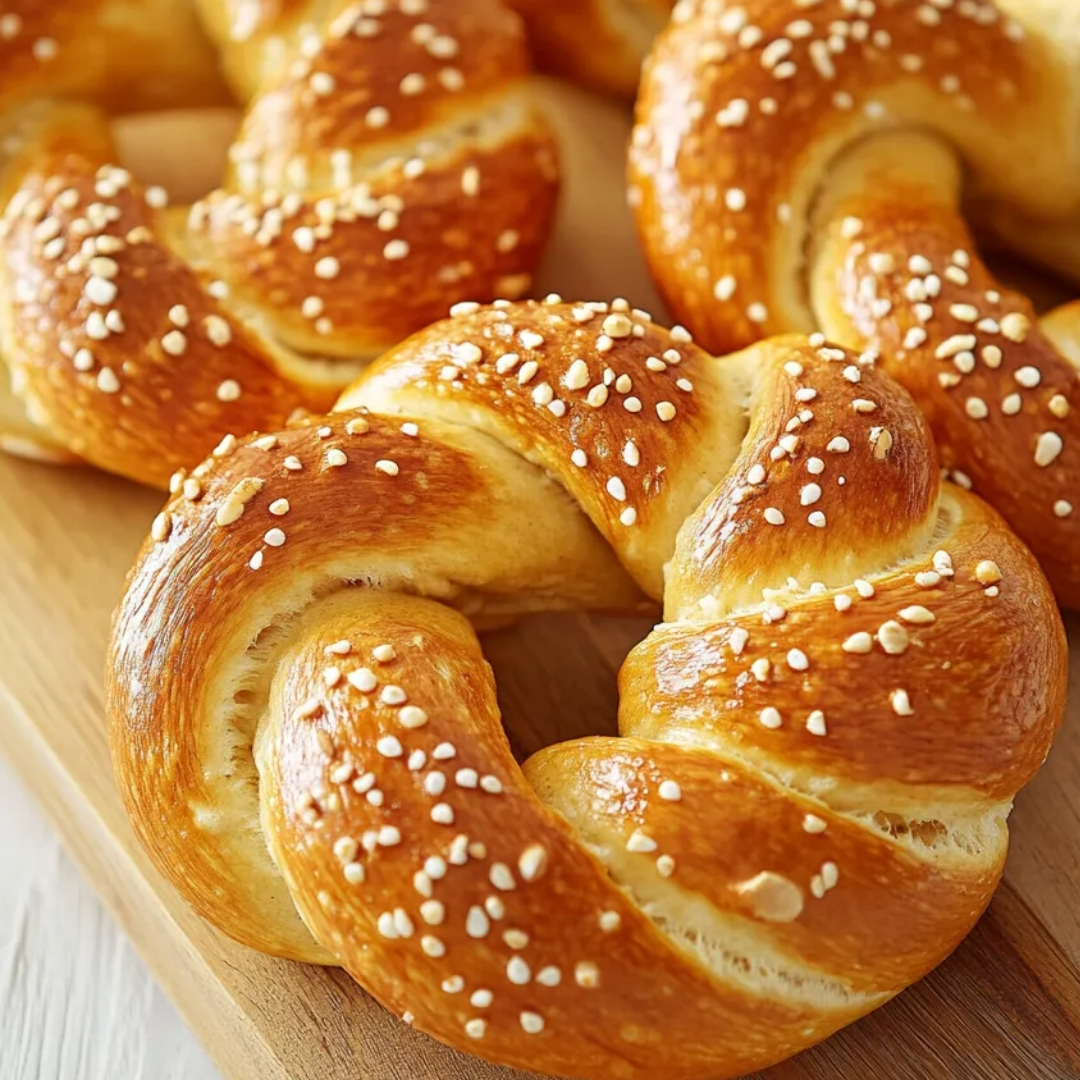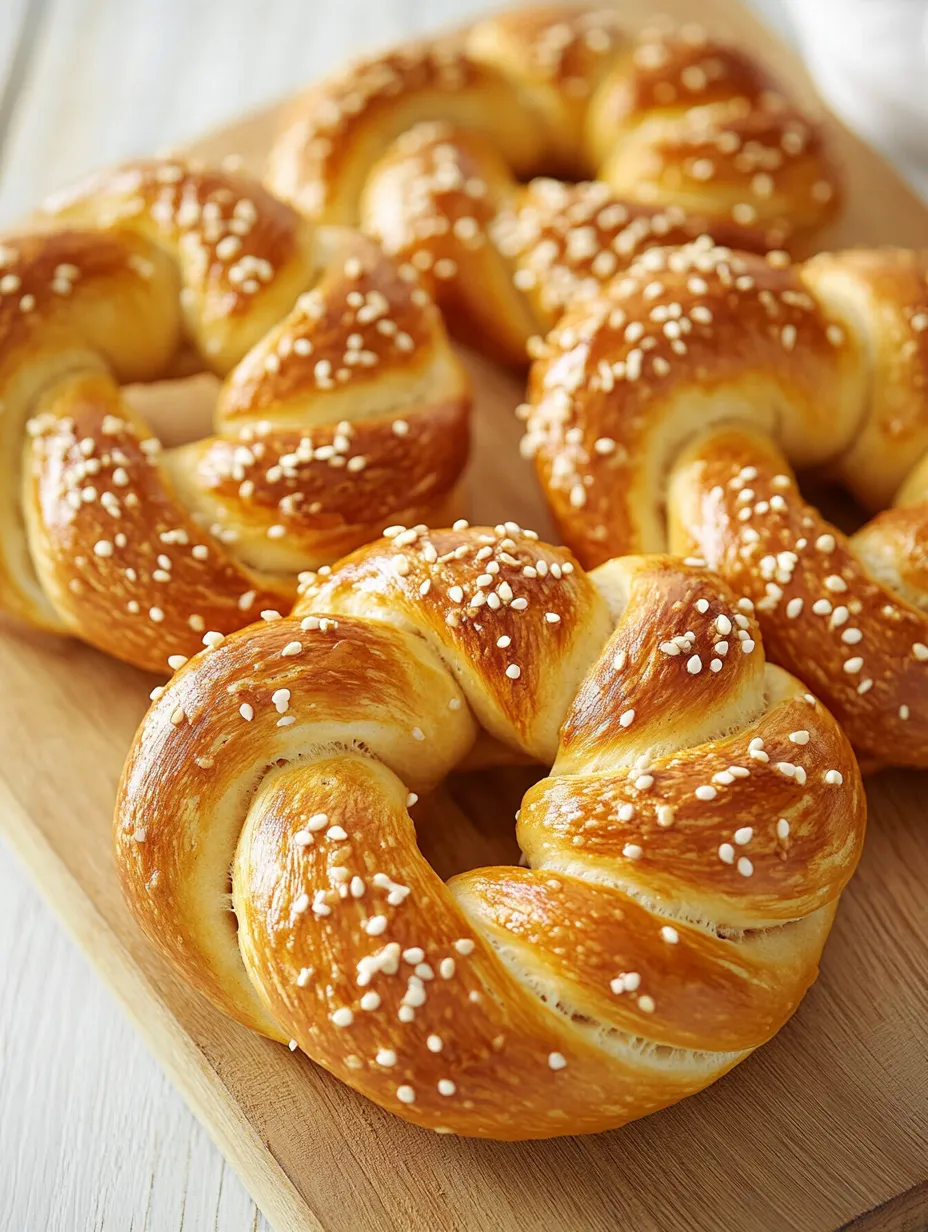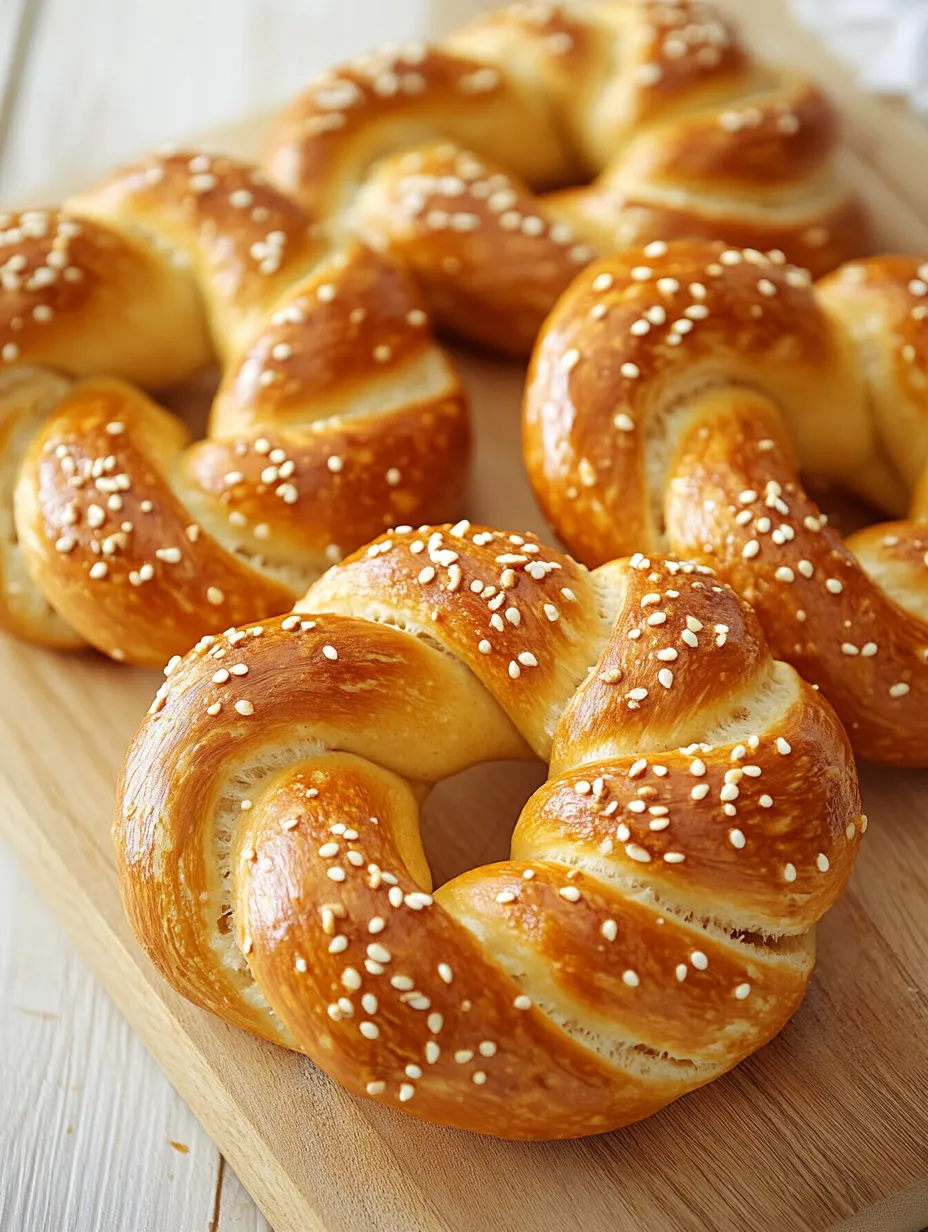 Pin it
Pin it
There's nothing quite like the warm, comforting aroma of homemade pretzels baking in the oven. These golden-brown treats, with their perfectly chewy texture and signature salty crust, bring a sense of nostalgia and warmth to any kitchen. Making pretzels from scratch may seem intimidating, but with a few simple ingredients and some patience, you can create these beloved classics right in your own home, customizing them with your favorite toppings and creating memories that last far longer than the pretzels themselves.
I started making homemade pretzels with my children years ago when they were small, looking for a rainy day activity that would keep little hands busy. What began as a simple baking project quickly became one of our most cherished family traditions. My kids would gather around the counter, eagerly rolling dough into ropes and attempting to twist them into that classic pretzel shape – with varying degrees of success! Their absolute favorite was always sesame pretzels, and they'd sprinkle the seeds with such concentration you'd think they were handling precious gems. Now that they're older, they still request our pretzel-making sessions, and those warm, fragrant treats always bring us back to those early days of flour-dusted countertops and contagious laughter.
Ingredients You'll Need
- Warm water: The temperature matters! It should be 110-115°F to properly activate the yeast without killing it.
- Active dry yeast: The leavening agent that gives pretzels their fluffy interior.
- Granulated sugar: Feeds the yeast and adds a subtle sweetness to balance the salt.
- Vegetable oil: A small amount adds tenderness to the dough.
- Bread flour: Higher protein content creates that characteristic chewy texture.
- Salt: Enhances flavor in the dough itself.
- Baking soda: Creates the alkaline bath that gives pretzels their distinctive crust and flavor.
- Egg: For brushing the pretzels before baking, creating a beautiful golden finish.
- Coarse sea salt: The classic topping that gives pretzels their signature flavor.
- Optional toppings: Sesame seeds, nigella seeds, poppy seeds, everything bagel seasoning, or cinnamon sugar for variety.
 Pin it
Pin it
How To Make Homemade Pretzels
- Step 1:
- Begin by activating the yeast. In a large mixing bowl, combine 1½ cups of warm water (110-115°F) with 1 tablespoon of sugar and 2 tablespoons of vegetable oil. Sprinkle 2¼ teaspoons (one packet) of active dry yeast over the surface and let it sit for about 5 minutes until it becomes foamy. This step is crucial – if your yeast doesn't foam, it may be inactive, and you'll need to start again with fresh yeast.
- Step 2:
- While the yeast activates, measure out 4 cups of bread flour and 1 teaspoon of salt in a separate bowl. The bread flour's higher protein content will give your pretzels that authentic chewy texture that sets them apart from those made with all-purpose flour. When the yeast is foamy, gradually add the flour mixture to the yeast mixture, stirring until a shaggy dough forms.
- Step 3:
- Turn the dough out onto a lightly floured surface and knead for 5-7 minutes. This step develops the gluten in the flour, which is essential for that classic pretzel texture. The dough should become smooth and elastic – when you press it with your finger, it should spring back slightly. If the dough feels too sticky, add a little more flour, one tablespoon at a time.
- Step 4:
- Place the dough in a lightly oiled bowl, turning once to coat both sides. Cover with a clean kitchen towel or plastic wrap and let it rise in a warm, draft-free spot for about an hour, or until doubled in size. The rising time may vary depending on the temperature of your kitchen – in warmer environments, the dough will rise faster than in cooler ones.
- Step 5:
- While the dough rises, prepare your workspace by preheating your oven to 425°F and lining two baking sheets with parchment paper. Lightly grease the parchment to prevent the pretzels from sticking after they're boiled. This is also a good time to prepare the baking soda bath by bringing 6 cups of water and ⅓ cup of baking soda to a gentle boil in a large pot.
- Step 6:
- Once the dough has doubled in size, gently punch it down to release the air bubbles and turn it out onto a clean surface. Divide the dough into 12 equal pieces – a kitchen scale is helpful here, but you can also eyeball it. Let the pieces rest for about 5 minutes to allow the gluten to relax, which will make them easier to roll out.
- Step 7:
- Now comes the fun part – shaping the pretzels! Roll each piece of dough into a long rope, approximately 20-22 inches in length. To form the classic pretzel shape, make a U-shape with the rope, then cross the ends over each other twice to create a twist, and finally bring the ends down to the bottom of the U, pressing them slightly to secure the shape. Place the shaped pretzels on your prepared baking sheets.
- Step 8:
- Working with one pretzel at a time, carefully lower it into the gently boiling baking soda bath using a slotted spatula. Boil for approximately 30 seconds, then remove and return it to the baking sheet. This alkaline bath is what gives pretzels their distinctive flavor and chewy crust – don't skip this step! Traditional German pretzels use food-grade lye for an even more authentic result, but baking soda is a safe and effective alternative for home bakers.
- Step 9:
- After all the pretzels have been boiled, brush each one with beaten egg using a pastry brush. This egg wash will give the pretzels a beautiful glossy finish as they bake. Now is the time to add your toppings – sprinkle with coarse sea salt for classic pretzels, or get creative with sesame seeds, nigella seeds, poppy seeds, or everything bagel seasoning for savory variations. For sweet pretzels, you can skip the salt and prepare to add cinnamon sugar after baking.
- Step 10:
- Bake the pretzels in your preheated oven for 12-14 minutes, or until they're a deep golden brown. The exact baking time will depend on your oven, so start checking them at the 10-minute mark. Once baked, transfer them to a wire rack to cool slightly. Pretzels are best enjoyed warm, when they're at their freshest and most aromatic.
The magic of homemade pretzels lies in their perfect contrast of textures – a slightly crisp, chewy exterior giving way to a soft, tender interior. That distinctive pretzel flavor comes from the baking soda bath, which creates a reaction on the surface of the dough that's impossible to achieve through baking alone. The result is a treat that's simultaneously simple and sophisticated, equally at home at a casual gathering or as an impressive addition to a special meal.
What makes this recipe particularly special is its versatility. While the classic salted pretzel is a timeless favorite, you can easily transform the basic dough into endless variations. For sweet-tooth satisfaction, brush baked pretzels with melted butter and dip in cinnamon sugar. For a savory twist, try adding garlic and parmesan before baking, or mix herbs directly into the dough for an aromatic variation.
I love serving these pretzels with an assortment of dipping options – a sharp mustard, cheese sauce, or honey butter for savory versions, and chocolate ganache or caramel sauce for sweet variations. They're perfect for game day gatherings, after-school snacks, or alongside a hearty bowl of soup or stew. And there's something undeniably special about pulling a batch of homemade pretzels from the oven when friends or family are visiting – the incredible aroma alone is worth the effort!
I've found that the temperature of your kitchen can significantly impact the rising time of the dough. In colder months, I often place the covered dough near (not on) a warm oven or in the microwave with a cup of hot water beside it to create a warm environment. This simple trick helps the dough rise consistently regardless of season.
For families with younger children, consider turning pretzel-making into a fun activity by allowing each child to shape their own pretzel. Traditional shapes are wonderful, but creative designs like letters, hearts, or even animals can make the experience even more memorable. My own children would often compete to see who could make the most perfect pretzel shape – a friendly rivalry that added an extra layer of fun to our baking sessions.
If you're planning to serve these pretzels at a party, consider making pretzel bites instead of full-sized pretzels. Simply cut the ropes of dough into 1-2 inch pieces before boiling and baking. These bite-sized treats are perfect for dipping and easier for guests to enjoy while mingling.
 Pin it
Pin it
My final thought on homemade pretzels is that they represent one of the most rewarding aspects of home baking – the ability to create something with your own hands that connects you to culinary traditions spanning centuries and continents. The process of mixing, kneading, shaping, and baking these twisted treats offers a satisfying tactile experience that's increasingly rare in our digital world. Whether you're making them alone for some meditative baking therapy or involving the whole family in a fun kitchen project, homemade pretzels deliver both culinary delight and emotional connection – a truly perfect combination.
Frequently Asked Questions
- → Why do you boil pretzels in baking soda water?
- The baking soda bath is crucial as it gelatinizes the outside of the pretzel, creating that distinctive chewy crust and characteristic pretzel flavor. It also helps them achieve that beautiful golden-brown color when baked.
- → Can I make these pretzels ahead of time?
- Yes, you can prepare the dough a day ahead and refrigerate it. Let it come to room temperature before shaping. Alternatively, you can freeze shaped, unboiled pretzels and finish the boiling and baking steps later.
- → What's the best way to store and reheat homemade pretzels?
- Store in an airtight container at room temperature for 1-2 days. To refresh, sprinkle with a little water and reheat in a 350°F oven for 5-10 minutes. For longer storage, freeze baked pretzels and reheat from frozen.
- → Can I use all-purpose flour instead of bread flour?
- Yes, all-purpose flour works fine, though bread flour produces a slightly chewier texture due to its higher protein content. If using all-purpose, you may need to adjust the amount slightly as it absorbs less moisture.
- → What dipping sauces go well with homemade pretzels?
- Classic options include spicy mustard, beer cheese dip, or honey mustard. For a sweet twist, try cinnamon sugar pretzels with cream cheese frosting or chocolate sauce. A simple cheese sauce is always popular with kids.
